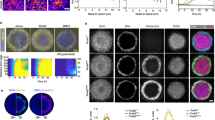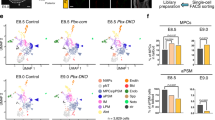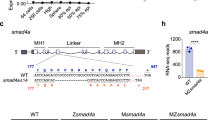Abstract
Nodal-related members of the transforming growth factor (TGF)-β family regulate the induction of mesoderm, endoderm, and mesendoderm, a tissue specific to the Spemann organizer1,2,3,4,5,6,7. How these different tissues form in response to the same signalling molecules is not completely understood. It has been suggested that concentration-dependent effects, mediated by extracellular cofactors and antagonists, are responsible for the differences1,8,9,10. Here we show that the nuclear protein Arkadia specifically potentiates the mesendoderm-inducing activity of a subset of TGF-β family members. The combined activities of Arkadia and Xenopus nodal-related-1 are sufficient to induce mesendoderm and suppress mesoderm. Arkadia dorsalizes ventral tissues, resulting in the induction of organizer-specific gene expression. Blocking nodal signalling extracellularly inhibits these effects. Arkadia influences nodal activity when co-expressed and can function in cells adjacent to those producing the nodal signal. Our findings, together with the observation that Arkadia mutant mice lack a node and node-derived mesendoderm, identify Arkadia as an essential modulator of the nodal signalling cascade that leads to induction of Spemann's organizer.
This is a preview of subscription content, access via your institution
Access options
Subscribe to this journal
Receive 51 print issues and online access
$199.00 per year
only $3.90 per issue
Buy this article
- Purchase on Springer Link
- Instant access to full article PDF
Prices may be subject to local taxes which are calculated during checkout





Similar content being viewed by others
References
Schier, A. F. & Shen, M. M. Nodal signalling in vertebrate development. Nature 403, 385–389 (1999).
Jones, C. M., Kuehn, M. R., Hogan, B. L. M., Smith, J. C. & Wright, C. V. E. Nodal-related signals induce axial mesoderm and dorsalize mesoderm during gastrulation. Development 121, 3651–3662 (1995).
Conlon, F. L. et al. A primary requirement for nodal in the formation and maintenance of the primitive streak in the mouse. Development 120, 1919–1928 (1994).
Feldman, B. et al. Zebrafish organizer development and germ-layer formation require nodal-related signals. Nature 395, 181–185 (1998).
Rebagliati, M. R., Toyama, R., Fricke, C., Haffter, P. & Dawid, I. B. cyclops encodes a nodal-related factor involved in midline signaling. Proc. Natl Acad. Sci. USA 95, 9932–9937 (1998).
Sampath, K. et al. Induction of the zebrafish ventral brain and floorplate requires cyclops/nodal signalling. Nature 395, 185–189 (1998).
Zhou, X., Sasaki, H., Lowe, L., Hogan, B. L. M. & Kuehn, M. R. Nodal is a novel TGF-β-like gene expressed in the mouse node during gastrulation. Nature 361, 543–547 (1993).
Piccolo, S. et al. The head inducer Cerberus is a multifunctional antagonist of Nodal, BMP and Wnt signals. Nature 397, 707–710 (1999).
Gritsman, K. et al. The EGF-CFC protein one-eyed pinhead is essential for nodal signaling. Cell 97, 121–132 (1999).
Bisgrove, B. W., Essner, J. J. & Yost, H. J. Regulation of midline development by antagonism of lefty and nodal signaling. Development 126, 3253–3262 (1999).
Episkopou, V. et al. Induction of the mammalian node requires Arkadia function in the extra- embryonic lineages. Nature 410, 825–830 (2001).
Graff, J. M., Thies, R. S., Song, J. J., Celese, A. J. & Melton, D. A. Studies with a Xenopus BMP receptor suggest that ventral mesoderm-inducing signals override dorsal signals in vivo. Cell 79, 169–179 (1994).
Suzuki, A. et al. A truncated bone morphogenetic protein receptor affects dorsal-ventral patterning in the early Xenopus embryo. Proc. Natl Acad. Sci. USA 91, 10255–10259 (1994).
Piccolo, S., Sasai, Y., Lu, B. & De Robertis, E. M. Dorsoventral patterning in Xenopus: inhibition of ventral signals by direct binding of chordin to BMP-4. Cell 86, 589–598 (1996).
Zimmerman, L. B., De Jesus-Escobar, J. M. & Harland, R. M. The Spemann organizer signal noggin binds and inactivates Bone Morphogenetic Protein 4. Cell 86, 599–606 (1996).
Dale, L. & Jones, C. M. BMP signalling in early Xenopus development. BioEssays 21, 751–760 (1999).
Smith, J. C., Price, B. M., Green, J. B., Weigel, D. & Herrmann, B. G. Expression of a Xenopus homolog of Brachyury (T) is an immediate-early response to mesoderm induction. Cell 67, 79–87 (1991).
Jones, C. M., Dale, L., Hogan, B. L., Wright, C. V. & Smith, J. C. Bone morphogenetic protein-4 (BMP-4) acts during gastrula stages to cause ventralization of Xenopus embryos. Development 122, 1545–1554 (1996).
Clements, D., Friday, R. V. & Woodland, H. R. Mode of action of VegT in mesoderm and endoderm formation. Development 126, 4903–4911 (1999).
Agius, E., Oelgeschlager, M., Wessely, O., Kemp, C. & DeRobertis, E. M. Endodermal Nodal-related signals and mesoderm induction in Xenopus. Development 127, 1173–1183 (2000).
Armes, N. A. & Smith, J. C. The ALK-2 and ALK-4 activin receptors transduce distinct mesoderm-inducing signals during early Xenopus development but do not co-operate to establish thresholds. Development 124, 3797–3804 (1997).
Sampath, K., Cheng, A. M. S., Frisch, A. & Wright, C. V. E. Functional differences among Xenopus nodal-related genes in left-right axis determination. Development 124, 3293–3302 (1997).
Yasuo, H. & Lemaire, P. A two-step model for the fate determination of presumptive endodermal blastomeres in Xenopus embryos. Curr. Biol. 9, 869–879 (1999).
Osada, S. I. & Wright, C. V. E. Xenopus nodal-related signaling is essential for mesendodermal patterning during early embryogenesis. Development 126, 3229–3240 (1999).
Sun, B. I. et al. derriere: a TGF-beta family member required for posterior development in Xenopus. Development 126, 1467–1482 (1999).
Zhang, J. et al. The role of maternal VegT in establishing the primary germ layers in Xenopus embryos. Cell 94, 515–524 (1998).
Kofron, M. et al. Mesoderm induction in Xenopus is a zygotic event regulated by maternal VegT via TGFb growth factors. Development 126, 5759–5770 (1999).
Massague, J. & Chen, Y.-G. Controlling TGF-b signaling. Genes Dev. 14, 627–644 (2000).
Cheng, A. M., Thisse, B., Thisse, C. & Wright, C. V. The lefty-related factor Xatv acts as a feedback inhibitor of Nodal signaling in mesoderm induction and L-R axis development in Xenopus. Development 127, 1049–1061 (2000).
Acknowledgements
We thank S. Piccolo for the Cer-S construct, and A. Ashworth, T. Enver, B. Feldman, A. Swain and members of the Jones laboratory for comments on the manuscript.
Author information
Authors and Affiliations
Corresponding author
Supplementary information

A.
Arkadia does not enhance the activity of activin protein in animal caps. Arkadia was expressed in the animal hemisphere by injection of RNA at the 2-cell stage. Animal caps were explanted at stage 8-9 and transferred into medium containing different concentrations of activin protein. No co-operation with the inductive effects of activin was observed. Results were confirmed by assaying the explants for molecular markers by RT-PCR (not shown).

B.
Arkadia expressing cells recruit non-expressing cells into secondary axes. Arkadia RNA was coinjected with nuclear beta gal RNA. Arkadia expressing cells (blue) populate all tissues in the secondary axes.

C.
Morphology of VegT expressing animal caps in the presence of Arkadia, and/or Cer-S. Arkadia has little effect on the morphology of VegT induced explants, but enhances endoderm formation while partially suppressing mesoderm formation (see molecular data in Figure 3).
Rights and permissions
About this article
Cite this article
Niederländer, C., Walsh, J., Episkopou, V. et al. Arkadia enhances nodal-related signalling to induce mesendoderm. Nature 410, 830–834 (2001). https://doi.org/10.1038/35071103
Received:
Accepted:
Issue Date:
DOI: https://doi.org/10.1038/35071103
This article is cited by
-
Loss of deubiquitylase USP2 triggers development of glioblastoma via TGF-β signaling
Oncogene (2022)
-
Breast cancer metastasis suppressor OTUD1 deubiquitinates SMAD7
Nature Communications (2017)
-
Nuclear receptor NR4A1 promotes breast cancer invasion and metastasis by activating TGF-β signalling
Nature Communications (2014)
-
Efficient TGF-β/SMAD signaling in human melanoma cells associated with high c-SKI/SnoN expression
Molecular Cancer (2011)
-
Making a commitment: cell lineage allocation and axis patterning in the early mouse embryo
Nature Reviews Molecular Cell Biology (2009)
Comments
By submitting a comment you agree to abide by our Terms and Community Guidelines. If you find something abusive or that does not comply with our terms or guidelines please flag it as inappropriate.



